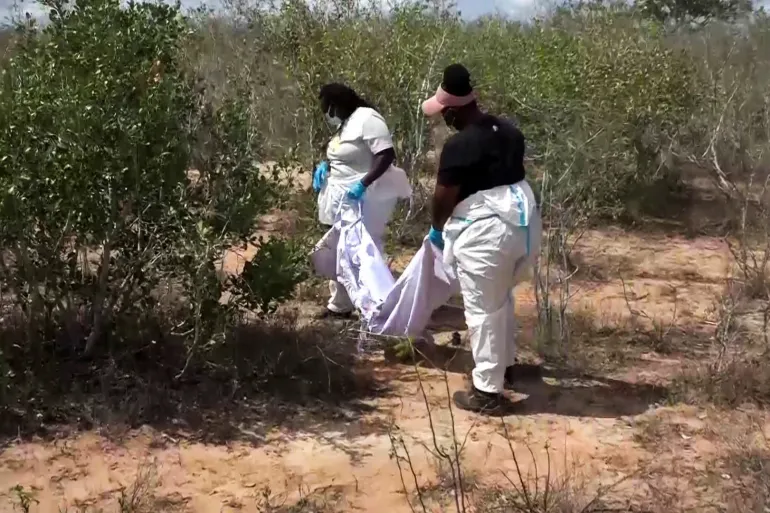11 suspects held as probe into Kwa Binzaro cult killings deepens

Inspector General of Police Douglas Kanja said investigators have established that a number of the victims were brought into the country from Asia before being radicalised and eventually killed.
Police have arrested 11 people in connection with the Kwa Binzaro cult killings in Kilifi County, where at least 34 bodies have been exhumed and more than 100 human remains recovered.
Inspector General of Police Douglas Kanja confirmed the arrests, saying preliminary findings suggest many victims were not locals.
Speaking after inspecting the graves on Wednesday, Kanja said investigators have established that a number of the victims were brought into the country from Asia before being radicalised and eventually killed.
“The investigators are actually on top of that, and very soon we’re actually going to get to know what really happened, but we are aware that many of the people who have been brought here were procured from Asia; they are not locals. They are from other places, brought here radicalised and then at the end of the day they lost their lives that way,” he told journalists on Wednesday.
Kanja said four of the suspects have been identified as the key planners, while the Directorate of Criminal Investigations (DCI) is working to uncover the motive behind the deaths.
The suspects were arrested following a complaint by a woman who reported the deaths of her children.
During a court session in Malindi, police requested more time to detain the 11, saying a month-long extension was needed to allow further investigations, including tracing money transfers on their phones believed to have funded the cult’s activities.
Court documents reveal that the group initially rented houses in Malindi before relocating to the remote Chakama Ranch in Kwa Binzaro, where they built mud huts near the mass graves.
The suspects have been named as Jairus Otieno Odere, Lilian Akinyi, Kahonzi Katana Karisa, Loice Zawadi, Safari Kenga Nzai, Karisa Gona Fondo, Gona Charo Kalama, Kahindi Kazungu Garama, Thomas Mukonwe, James Kahindi and Sharleen Temba Anido. They are facing allegations of organised crime, radicalisation, aiding terrorism and murder.
The revelations have once again raised questions about security agencies’ response to cult-related crimes.
The National Police Service recently admitted failures in handling the Kwa Binzaro case, pointing to weaknesses in intelligence gathering, investigations and coordination.
“Despite the lessons drawn from the Shakahola tragedy, which shocked the country last year, a similar situation has once again unfolded, raising questions over preparedness and response,” Police spokesperson Michael Muchiri said.
Exhumations have now been paused to allow DNA analysis of collected samples. Government pathologist Dr Richard Njoroge said postmortem examinations would begin after X-ray procedures are completed.
Kanja assured that a multi-agency team is working on the ground to uncover the truth, but noted the vast size of Chakama Ranch complicates operations.
“This is a very expansive and forested area, and for that reason, it needs all of us to come together so that we can overcome these challenges,” he said.
The Kwa Binzaro massacre marks the second mass exhumation linked to cult practices within Chakama Ranch, which lies just two kilometres from Shakahola.
Last year, more than 400 bodies were unearthed near Paul Mackenzie’s Good News International Church in Shakahola, and Mackenzie remains in custody.
Victor Kaudo of the Malindi Community Human Rights Centre has urged the government to declare the Kwa Binzaro tragedy a national disaster.
“When children arrived at the five-acre home located in the Kwa Binzaro area, they were happy that they had found a new home; unknown to them, the torture that awaited them,” Kaudo said.
“We are witnessing pregnant women being exhumed here. This calls for the government to give this matter the importance it deserves.”
Investigators are now pursuing leads into how the Kwa Binzaro cult was financed. Early findings suggest that the group had an organised structure that facilitated recruitment, radicalisation and concealment of its operations.
